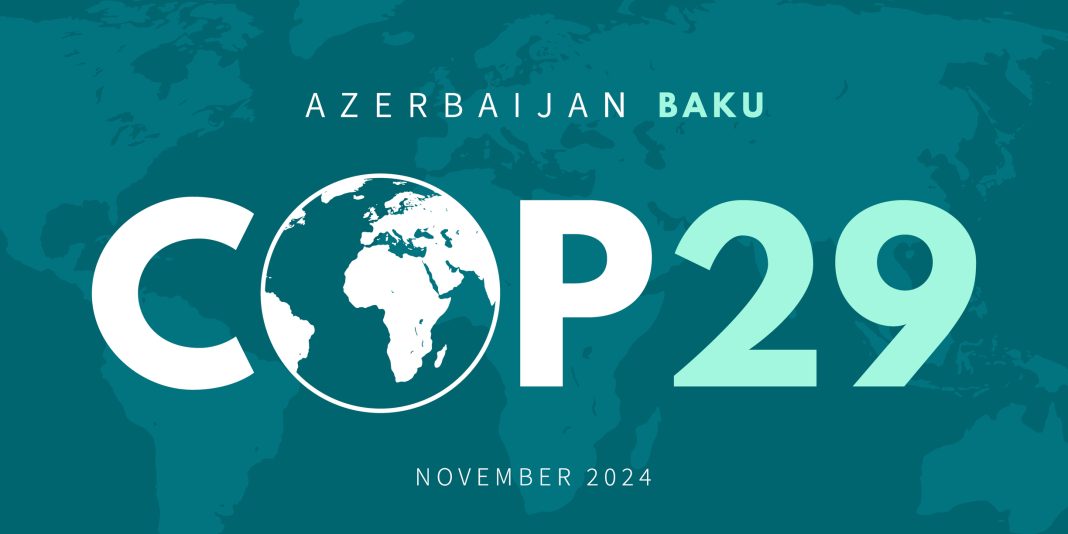Professor of International Relations at the University of Leeds, Richard Beardsworth, looks with concern to this November’s COP29 and the US elections. The issue is climate leadership
The next UNFCCC Conference of the Parties, COP29, begins in Baku, Azerbaijan, on November 11th, six days after the U.S. general election. The conjuncture of these two dates is of critical importance for the future of climate action and the future of climate leadership driving it. This article rehearses what is at stake ahead of COP29 and where climate leadership stands in relation to it. Whatever the final plot, November is a month to be remembered.
The Agenda at COP29
On the table at COP29 are two critical agendas: 1) the re-setting of Nationally Determined Contribution targets (NDCs) for the next five-year period (2025-2030); and 2) the recalibration of climate finance. Let us backtrack to 2023 to understand their importance. The purpose of COP28 was to address the first Global Stocktake (GST) on GHG emissions since the 2015 Paris Agreement and its setting of the limit of 1.5C increase in average global temperature by 2100.
The GST report underlined the fact that, to remain 1.5C compatible, the world needed to peak GHG emissions by 2025 at the latest and reduce them by 43% by 2030 (baseline 2019) and 65% by 2030. It confirmed that the world was ‘off track’, rising 0.2C per decade.
The cover decision of COP28, the UAE Consensus, spoke for the first time of the need to ‘transition away from fossil fuels’, and of ‘tripling renewable energy’ and ‘doubling energy efficiency’ to re-align with the Paris Agreement. It also reiterated that climate finance was the motor of climate action, although finance remained essentially off the negotiating table.
Baku’s importance lies here. First, by COP29, all countries must align their NDCs in the five years up to 2030 with 1.5C (amounting to the global emissions reduction target of 43% by 2030). Second, all countries must agree on a new goal to provide climate finance to address the needs of developing countries with regard to the effects of climate change. This goal – entitled awkwardly the ‘New Collective Quantified Goal on Climate Finance’ (NCQG) – will replace the $100 billion target per annum set at COP15 in 2009 and to be completed by 2020 (exceeded in 2022). The two goals are interrelated. Without the second, for example, the first is unachievable since the provision of finance to developing countries will create the trust on which collective global goals, disaggregated into national targets in the Paris Agreement, can be achieved. Where do things stand?
Stalemate
Each COP is preceded by technical negotiations, which were organised in Bonn in June. It is widely accepted that this June, the talks advanced little. Ambitious NDCs (to meet the 43% global reduction target by 2030) are incompatible with the continuing targets of fossil fuel producers, of which Azerbaijan. Positions between the developed and developing countries on the financial target for the NCQG, the donor base for it (whether to include the wealthy emerging countries or not), and the modality of the finance granted remained polarised given current geopolitical circumstances. For example, to achieve a goal of circa $1 trillion per annum, donor countries sought to expand the base of financial provision (both countries and financing sources). However, the negotiating blocs of developing countries refused to consider this expansion on the principle of historical responsibility and common, but differentiated responsibilities.
Climate leadership
If COP29 climate negotiations are to move the dial, political resolution is necessary. Climate leadership by domestic and international example offers, in present circumstances, the only way in which resolution is possible. The ‘troika’ of COP presidencies (UAE COP28, Azerbaijan COP29 and Brazil COP30) proposes to set an example by publicising, prior to November, 1.5C-aligned NDCs. With all three countries planning to increase their fossil fuel production well beyond 2030, these national examples risk meaninglessness.
The G2: U.S. and China
The two countries leading, respectively, the developed and developing world are the U.S. and China. They are also the biggest historical and current emitters. According to any political analysis, to unblock the situation, they must ultimately take the lead and show the way both beyond fossil fuel extraction and towards international financial cooperation. Present signs are poor: China’s NDC target of 2030 does not deliver emission reductions. The U.S.’s current emissions reduction target of 50-52% (baseline 2005) by 2030 is not 1.5C compatible; it is increasing its LNG capacity by 40% by 2026 and continuing to drill on federal lands and invest in fossil fuel production abroad.
In this context and at this conjuncture, coming six days before COP29, the U.S. presidential elections could not be more important. China will probably not show its diplomatic hand until after the election. If Trump wins, fossil fuel production will increase, aggressive trade-barriers will be placed on Chinese exports, and the U.S. will again pull out of the Paris Agreement, serving as a bad example and cover to other countries internationally. If Harris wins, the Biden administration’s climate legacy around the Inflation Reduction Act will be maintained, but her own administration will need to address fossil fuels and international climate finance to point the way forward globally. There is a high probability that China and the U.S. will only assume joint leadership on climate in this latter mix.
From the U.S. election to the end of COP29, the climate stakes are very high. Whatever the outcomes, the world will remember November.


